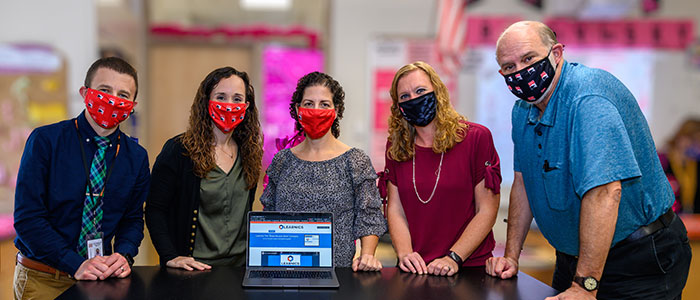ESU-Driven Start-Up Awarded Nearly $1Million National Science Foundation Grant

Posted by: Elizabeth Richardson on October 8, 2021, No Comments
Photo: from left to right: Scott Oste, Northampton Area School District Secondary Curriculum Supervisor; Michelle Schoeneberger, Northampton Area School District Assistant Superintendent and ESU Doctoral Cohort 8 Graduate; Michelle Cook, Flemington-Raritan School District Supervisor of Curriculum and Instruction and ESU Doctoral Cohort 8 Graduate; Kristen Sevinsky, Northampton Area School District Middle School Science Teacher; and Douglas Lare, Ed.D., retired Distinguished Professor
School districts typically spend considerable efforts trying to keep students safe online and away from the dangers that lurk in cyberspace as kids use their laptops for assignments.
But fewer schools employ software that monitors student online learning experiences as a way of making teachers more effective and improving kids’ research skills.
That’s where Learnics comes in. The fledgling company, which was founded by an East Stroudsburg University professor and ESU doctoral student, was recently awarded a nearly $1 million grant from the National Science Foundation to further test and hone its system that allows teachers to see the effectiveness of their lessons. Learnics Insight Link is a free Google Chrome Extension that enables students to capture and submit a record of their online learning experience as part of an assignment. Currently, Learnics creators are sharing the program for free with schools around the region to get more feedback from educators on its value.
The idea for Learnics grew out of dissertation discussions that Greg Cottrell, Ed.D., who was in the first cohort of graduates to earn ESU’s doctoral degree in educational leadership, had with now retired Distinguished Professor Douglas Lare, Ed.D.,who coordinated the program.
“I was at the time an assistant principal and we had a one-to-one Chromebook initiative where every student gets a laptop computer in my school,” said Dr. Cottrell, who is now principal of North Hunterdon High School in Annandale, N.J. “We would see all this activity students were doing online, basically their online browsing history. At the time we were using a lot of that information to keep students safe and address inappropriate behaviors. But we weren’t really doing anything to address learning behaviors and what we could do to help students have better learning experiences online.”
Lare and Cottrell came up with the idea of collecting targeted data about what students were doing online to complete assignments as a way to help teachers create more effective lessons. Cottrell gathered information manually for his dissertation and he and Lare teamed up with Lare’s son-in-law Karl Pietrzak to create software that collects the data automatically.
So, for example, if an assignment requires students to research a certain species of fish, Learnics can show the teacher what websites a student was on and for how long.
“We equate this to showing your work,” Cottrell said. “In a math class most math teachers don’t just ask their students to submit their answer, they also want to see the process that it took to get there.”
Among the first researchers for the project were then-ESU doctoral students Michelle Schoeneberger, Ed.D., assistant superintendent at Northampton Area School District, and Michelle Cook, Ed.D., supervisor of curriculum and instruction at Flemington-Raritan Regional School District.
Schoeneberger’s research looked at on how teachers used the Learnics tool and Cook focused on students.
“With a lot of companies, it’s about monitoring student behavior,” Cook said. “This is unique in that it is about supporting student learning and teacher instruction and not about behavior. The kids feel that difference.”
Schoeneberger agreed.
“The targeted data is very powerful,” she said. “It also has the potential to reveal that the teachers’ assignments aren’t as good as they think they are.”
Lare recalls how early on, he and Schoeneberger visited a middle school that was using Learnics data. They spoke to a science teacher who had given his students two days to complete an assignment on a type of worm.
“When he got the data back he found on average, students spent three to five minutes completing the assignment and then spent two days on the internet doing whatever they wanted,” said Lare.
“We’re trying to make the information more meaningful to the teachers in a way that doesn’t burden them,” Lare said.
One of the features that makes Learnics unique is its process for collecting targeted data.
“If I’m a teacher in an English class, I’m only going to get the targeted data about what that student is doing for that English assignment,” Cottrell said. “That teacher doesn’t need to know the thousand different websites that student has visited throughout a 24-hour period.”
The $945,000 National Science Foundation Small Business Innovation Research Phase II grant will fund research and development of Learnics, including looking at how it might be used in higher education. The project received a smaller NSF Phase I grant in 2019.
More than a dozen ESU students have been involved in the project and many teachers who graduated from ESU’s secondary education program are using Learnics in their jobs. The university’s Innovation Center connected Learnics with other resources, which helped them get a $60,000 Ben Franklin Technology Partners grant.
“It was definitely East Stroudsburg-driven, thanks to Doug and thanks to some other faculty members who took an interest in what we were doing,” Cottrell said.
The key now is to try to strike a balance between growing the business so it can sustain itself while “developing ideas that can have a dramatic impact on education,” Lare said. “We saw a need in K-12 education and we really took a lot of people and tried to address it.”
Search
Recent Posts

Provost’s Colloquium Series Presents “A Visitor Sentiment Analysis of PA Wineries: A Big Data Approach and A Guided Wine Tasting”
April 16, 2024 - Read more



